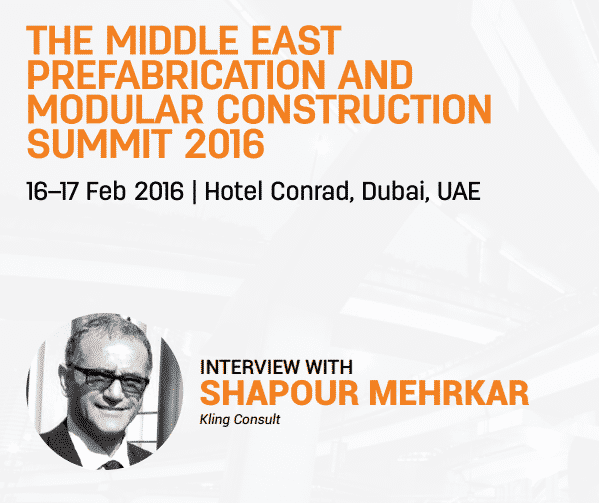The Middle East Prefabrication and Modular Construction Summit 2016
16- 17 Feb 2016 | Hotel Conrad, Dubai
Shapour Mehrkar was interviewed by the team at Information Exchange Group ahead of their upcoming event The Middle East Prefabrication and Modular Construction Summit 2016.
As per your interaction with construction industry, how is prefab and modular construction as a method helping the developers in project delivery?
If elements of the building can be built earlier in a factory and provided their weight and size are such that the transportation of them is not too costly plus placement of these elements in the building is possible, then significant time can be saved and to some extent cost. This reduction of time would help the developers to complete their project faster and start earning money or collecting the purchase price and reducing the interest that they should pay on their bank loans. Please note on other limitations for prefabrication explained in point c below.
How has structural designing in construction projects evolved with the inclusion of modular construction and prefabrication construction modules?
I do not believe it has been a question of evolving. The need to reduce time and cost has always been the driver for coming up with new ideas. In addition, prefabrication being done in a factory environment help to improve the quality control.
Modular construction has a list of benefits to itself. What are the challenges faced in a large scale construction projects involving this new construction method?
Firstly this is not a new construction method. It has been around for decades. The challenges are related to technology, design issues, transportation, storage areas at the site, weight & size of the elements, lifting limits of the equipment on site and initial costs. Any of these could limit the use of prefabrications or modular construction. If the number of elements being repeated is not high enough then prefabrication could become too expensive but if there is site restriction issues that in situ construction is not possible, then prefabrication could be the only solution.
How do you think cost overrun and time Delays can be minimized through prefabrication and modular construction methodologies?
Simply if it is possible to use prefabrication and there are no issues as explained in question c) then time and cost would be saved. How much time and cost is saved it really depends on the extent of modularization or prefabrication that can be applied to the project. For small projects the benefit is so limited that perhaps this is not going to have a big impact and probably because of the need to have large cranes or limited number of orders, it would not be viable at all.
How is 3D printing in construction being perceived? Can it be the next big thing in coming few years for the construction industry?
I am not sure that the 3D printing has yet reached to a point to affect the large scale and heavy industry construction projects. I don’t believe that the 3D printers can make concrete or good quality steel or very hard quality plastics. In the future things could be different and perhaps there would be more to be done with 3D printing.
What are your expectations from the summit and how do you rate the topics of the discussion at the summit?
I am sure that exchange of ideas would help to bring about new approaches that perhaps have not been explored. In addition, such a summit would help the practitioners find out about the latest ideas and innovations in the industry and also act as a Continuous Personal Development for younger members in the industry.

Shapour
 Constructionshows
Constructionshows